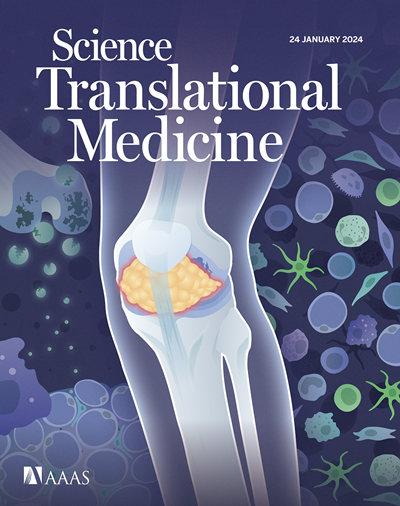A spatially resolved single-cell lung atlas integrated with clinical and blood signatures distinguishes COVID-19 disease trajectories
IF 15.8
1区 医学
Q1 CELL BIOLOGY
引用次数: 0
Abstract
COVID-19 is characterized by a broad range of symptoms and disease trajectories. Understanding the correlation between clinical biomarkers and lung pathology during acute COVID-19 is necessary to understand its diverse pathogenesis and inform more effective treatments. Here, we present an integrated analysis of longitudinal clinical parameters, peripheral blood markers, and lung pathology in 142 Brazilian patients hospitalized with COVID-19. We identified core clinical and peripheral blood signatures differentiating disease progression between patients who recovered from severe disease compared with those who succumbed to the disease. Signatures were heterogeneous among fatal cases yet clustered into two patient groups: “early death” (<15 days until death) and “late death” (>15 days). Progression to early death was characterized systemically and in lung histopathological samples by rapid endothelial and myeloid activation and the presence of thrombi associated with SARS-CoV-2+ macrophages. In contrast, progression to late death was associated with fibrosis, apoptosis, and SARS-CoV-2+ epithelial cells in postmortem lung tissue. In late death cases, cytotoxicity, interferon, and T helper 17 (TH17) signatures were only detectable in the peripheral blood after 2 weeks of hospitalization. Progression to recovery was associated with higher lymphocyte counts, TH2 responses, and anti-inflammatory–mediated responses. By integrating antemortem longitudinal blood signatures and spatial single-cell lung signatures from postmortem lung samples, we defined clinical parameters that could be used to help predict COVID-19 outcomes.
结合临床和血液特征的空间分辨单细胞肺图谱可区分 COVID-19 疾病轨迹
COVID-19 的特点是症状和疾病轨迹多种多样。了解急性 COVID-19 期间临床生物标志物与肺部病理之间的相关性对于了解其多样化的发病机制和提供更有效的治疗方法非常必要。在此,我们对 142 名巴西 COVID-19 住院患者的纵向临床参数、外周血标志物和肺部病理进行了综合分析。我们发现了核心临床和外周血特征,这些特征区分了重症康复患者和死亡患者的疾病进展。死亡病例的特征不尽相同,但可分为两组:"早期死亡"(15 天内死亡)和 "晚期死亡"(15 天内死亡)。在全身和肺组织病理学样本中,早期死亡的特征是内皮细胞和髓细胞迅速活化,并出现与 SARS-CoV-2+ 巨噬细胞相关的血栓。与此相反,晚期死亡的进展与纤维化、凋亡和死后肺组织中的 SARS-CoV-2+ 上皮细胞有关。在晚期死亡病例中,只有在住院两周后才能在外周血中检测到细胞毒性、干扰素和T辅助细胞17(TH17)特征。恢复期的进展与较高的淋巴细胞计数、TH2 反应和抗炎介导的反应有关。通过整合死前纵向血液特征和死后肺样本的空间单细胞肺特征,我们定义了可用于帮助预测 COVID-19 结果的临床参数。
本文章由计算机程序翻译,如有差异,请以英文原文为准。
求助全文
约1分钟内获得全文
求助全文
来源期刊

Science Translational Medicine
CELL BIOLOGY-MEDICINE, RESEARCH & EXPERIMENTAL
CiteScore
26.70
自引率
1.20%
发文量
309
审稿时长
1.7 months
期刊介绍:
Science Translational Medicine is an online journal that focuses on publishing research at the intersection of science, engineering, and medicine. The goal of the journal is to promote human health by providing a platform for researchers from various disciplines to communicate their latest advancements in biomedical, translational, and clinical research.
The journal aims to address the slow translation of scientific knowledge into effective treatments and health measures. It publishes articles that fill the knowledge gaps between preclinical research and medical applications, with a focus on accelerating the translation of knowledge into new ways of preventing, diagnosing, and treating human diseases.
The scope of Science Translational Medicine includes various areas such as cardiovascular disease, immunology/vaccines, metabolism/diabetes/obesity, neuroscience/neurology/psychiatry, cancer, infectious diseases, policy, behavior, bioengineering, chemical genomics/drug discovery, imaging, applied physical sciences, medical nanotechnology, drug delivery, biomarkers, gene therapy/regenerative medicine, toxicology and pharmacokinetics, data mining, cell culture, animal and human studies, medical informatics, and other interdisciplinary approaches to medicine.
The target audience of the journal includes researchers and management in academia, government, and the biotechnology and pharmaceutical industries. It is also relevant to physician scientists, regulators, policy makers, investors, business developers, and funding agencies.
 求助内容:
求助内容: 应助结果提醒方式:
应助结果提醒方式:


